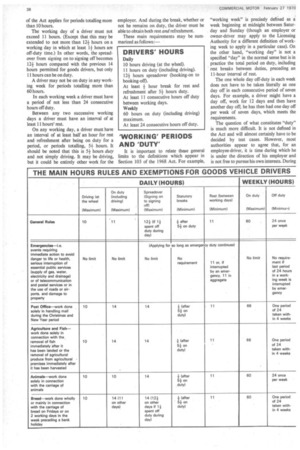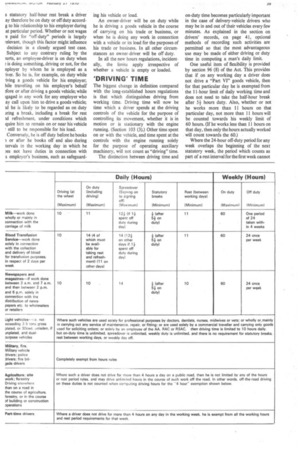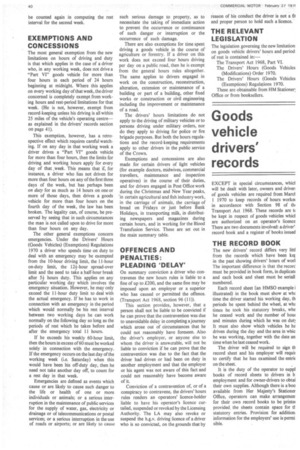Goods vehicle drivers' hours
Page 39

Page 40

Page 41

Page 42

If you've noticed an error in this article please click here to report it so we can fix it.
'ROM March 1 1970 new legal limits on Torking and driving hours apply to drivers I goods vehicles, and from March 15 to rivers of public service vehicles, and totor vehicles (other than p.s.v.) conmeted or adapted to carry more than 12 as sengers
There are also new record-keeping requiretents, and new penalties apply for infringeient of the hours and records legislation.
The hours limits and records requirements force from March completely supersede lose previously applied under sections 73 rid 186 of the Road Traffic Act 1960.
The Ministry of Transport has stated that se first three months of the new system. -om March 1, will be regarded as a transional period -during which Ministry aforcement staff will be concentrating on ringing the new rules to the attention of rivers and employers." There will thus be ame leniency at least until the end of May 970.
However, the new regulations take legal fleet in March, and CM has prepared le following guide in simple terms so that mployers, traffic staffs and drivers may have clear idea of what is involved.
This guide is divided into four sections:— ) A summary showing which classes of goods vehicle driver are affected by the respective hours requirements and main concessions.
) An explanation of the hours regulations for goods vehicle divers.
) A guide to record-keeping for goods vehicle drivers.
) An explanation of hours and records regulations affecting passenger vehicle drivers.
THE VEHICLES AFFECTED
From March 1 1 970 drivers of goods vehicles will have to comply with the limitations on driving and duty time specified in Section 96 of Part VI of the Transport Act 1968.
In this respect, goods vehicles include heavy or light locomotives and motor tractors (i.e. road tractors of all weights); the tractive units of articulated combinations; and motor vehicles constructed or adapted to carry goods other than the effects of passengers.
In general terms, this includes all vehicles constructed or adapted to carry or haul goods, and does not exclude lorry-mounted mobile plant, for example. And the restrictions apply, in general, to driving both on and off roads to which the public has access.
WHICH DRIVERS ARE COVERED?
There are two classes of goods driver who must conform with the new hours rules. These are:—
a) The employee-driver, defined in Section 95 (3) of the 1968 Act as a person who drives one of the specified types of vehicle in the course of his employment, and b) The owner-driver, defined as a person who drives such a vehicle for the purposes of a trade or business carried on by him.
For the hours regulations, references to "driving" by any person are references to those two categories of driving. So the new hours limits apply only to those people who drive in a working capacity.
A man who does not drive a "Part VI" vehicle—i.e. a goods vehicle covered by this section of the Transport Act—in the course of work is not bound by the hours rules if he drives such a vehicle for his own non-business purposes. He could, for instance, drive a large van for any period without restriction.
A man who drives a goods vehicle in the course of his employment, or as an ownerdriver on his trade or business, is nevertheless free to drive such vehicles without limit outside his employed (or self-employed) hours of duty. So an owner-driver can, for example, use his goods vehicle for personal non-business driving after completing the maximum permitted hours in connection with his trade or business.
THE NEW LIMITS
Briefly, the new limits on driving and working hours are set out below, although reference must be made to the definitions and exemptions which follow, in interpreting these limits for each individual case.
A driver may not, on any working day, drive a vehicle or vehicles to which Part VI of the Act applies for periods totalling more than 10 hours.
The working day of a driver must not exceed 11 hours. (Except that this may be extended to not more than 124 hours on a working day in which at least 1+ hours are off-duty time.) In other words, the spreadover from signing on to signing off becomes 12+ hours compared with the previous 14 hours permitted for goods drivers, butonly 11 hours can be on duty.
A driver may not be on duty in any working week for periods totalling more than 60 hours.
In each working week a driver must have a period of not less than 24 consecutive hours off duty.
Between any two successive working days a driver must have an interval of at least 11 hours' rest.
On any working day, a driver must have an interval of at least half an hour for rest and refreshment after being on duty for a period, or periods totalling, 5+ hours. It should be noted that this is 5+ hours duty and not simply driving. It may be driving, but it could be entirely other work for the employer. And during the break, whether or not he remains on duty, the driver must be able to obtain both rest and refreshment.
These main requirements may be summarized as follows:—
WORKING PERIODS AND 'DUTY'
It is important to relate these general limits to the definitions which appear in Section 103 of the 1968 Act. For example, "working week" is precisely defined as a week beginning at midnight between Saturday and Sunday (though an employer or owner-driver may apply to the Licensing Authority for a different definition of working week to apply in a particular case). On the other hand, "working day" is not a specified "day" in the normal sense but is in practice the total period on duty, including rest breaks between duties, preceding an 11-hour interval of rest.
The one whole day off-duty in each week does not have to be taken literally as one day off in each consecutive period of seven days. For example, a driver might have a day off, work for 12 days and then have another day off; he has then had one day off per week of seven days, which meets the requirements.
The question of what constitutes "duty" is much more difficult. It is not defined in the Act and will almost certainly have to be decided by test cases. However, most authorities appear to agree that, for an employee-driver, it is time during which he is under the direction of his employer and is not free to pursue his own interests. During
s statutory half-hour rest break a driver ay therefore be on duty or off duty accordg to his relationship to his employer during at particular period. Whether or not wages .e paid for "off-duty" periods is largely relevant, though this factor might influence decision in a closely argued test case. Subject to any contrary ruling by the )urts, an employee-driver is on duty when ! is doing something, driving or not, for the nployer by whom he is employed as a -iver. So he is, for example, on duty while -lying a goods vehicle for his employer; hile travelling on his employer's behalf !fore or after driving a goods vehicle; while 'gaged in any work for any employer who ay call upon him to drive a goods vehicle; id he is likely to be regarded as on duty ring a break, including a break for rest id refreshment, under conditions which quire him to remain on or near his vehicle
still to be responsible for his load.
Conversely, he is off duty before he books or after he books off and also during tervals in the working day in which he )es not have duties in connection with s employer's business, such as safeguard Mg his vehicle or load.
An owner-driver will be on duty while he is driving a goods vehicle in the course of carrying on his trade or business, or when he is doing any work in connection with a vehicle or its load for the purposes of his trade or business. In all other circumstances an owner-driver will be off duty.
In all the new hours regulations, incidentally, the limits apply irrespective of' whether a vehicle is empty or loaded.
'DRIVING' TIME
The biggest change in definition compared with the long-established hours regulations is that which distinguishes driving from working time. Driving time will now be time which a driver spends at the driving controls of the vehicle for the purpose of controlling its movement, whether it is in motion or is stationary with the engine running. (Section 103 (3).) Other time spent on or with the vehicle, and time spent at the controls with the engine running solely for the purpose of operating auxiliary machinery, will not count as "driving" time.
The distinction between driving time and on-duty time becomes particularly important in the case of delivery-vehicle drivers who may be in and out of their vehicles every few minutes. As explained in the section on drivers' records, on page 41, optional methods of recording such activities are permitted so that the most advantageous use may be made of either driving or duty time in computing a man's daily limit.
One useful item of flexibility is provided by section 96 (8) of the Act. This provides that if on any working day a driver does not drive a "Part VI" goods vehicle, then for that particular day he is exempted from the 11-hour limit of daily working time and does not need to take the half-hour break after 54 hours duty. Also, whether or not he works more than 11 hours on that particular day, not more than 11 hours will be counted towards his weekly limit of 60 hours. (If he works less than 11 hours on that day, then only the hours actually worked will count towards the 60.) Where the 24-hour off-duty period for any week overlaps the beginning of the next statutory week, the period which counts as part of a rest interval for the first week cannot be counted again in computing the rest interval for the second week.
EXEMPTIONS AND CONCESSIONS
The most general exemption from the new limitations on hours of driving and duty is that which applies in the case of a driver who, in any working week, does not drive a "Part VI" goods vehicle for more than four hours in each period of 24 hours beginning at midnight. Where this applies on every working day of that week, the driver concerned is completely exempt from working hours and rest-period limitations for that week. (He is not, however, exempt from record-keeping unless his driving is all within 25 miles of the vehicle's operating centre— as explained in the drivers' records section on page 41).
This exemption, however, has a retrospective effect which requires careful watching. If on any day in that working week a driver drives a "Part VI" goods vehicle for more than four hours, then the limits for driving and working hours apply for every day of that week. This means that if, for instance, a driver who has not driven for more than four hours on any of the first three days of the week, but has perhaps been on duty for as much as 14 hours on one or more of those days, then drives a goods vehicle for more than four hours on the fourth day of the week, the law has been broken. The legality can, of course, be preserved by seeing that in such circumstances the man is not called upon to drive for more than four hours on any day.
The other general exemptions concern emergencies. Under the Drivers' Hours (Goods Vehicles) (Exemptions) Regulations 1970 a driver who spends time on duty to deal with an emergency may be exempted from the 10-hour driving limit, the 11-hour on-duty limit, the 12+-hour spread-over limit and the need to take a half-hour break after 5+ hours duty. This applies on any particular working day which involves the emergency situation. However, he may only exceed the 11-hour duty limit to deal with the actual emergency. If he has to work in connection with an emergency in the period which would normally be his rest interval between two working days he can work normally on the following day so long as the periods of rest which he takes before and after the emergency total 11 hours.
If he exceeds his weekly 60-hour limit, then the hours in excess of 60 must be worked solely in connection with the emergency. If the emergency occurs on the last day of the working week (i.e. Saturday) when this would have been his off-duty day, then he need not take another day off, to count for a rest day in that week.
Emergencies are defined as events which cause or are likely to cause such danger to the life or health of one or more individuals or animals; or a serious interruption in the maintenance of public services for the supply of water, gas, electricity or drainage or of telecommunications or postal services; or a serious interruption in the use of roads or airports; or are likely to cause such serious damage to property, as to necessitate the taking of immediate action to prevent the occurrence or continuance of such danger or interruption or the occurrence of such damage.
There are also exemptions for time spent driving a goods vehicle in the course of agriculture or forestry. If a driver on this work does not exceed four hours driving per day on a public road, then he is exempt from the general hours rules altogether. The same applies to drivers engaged in work on the construction, reconstruction, alteration, extension or maintenance of a building or part of a building, other fixed works or construction or civil engineering including the improvement or maintenance of a road.
The drivers' hours limitations do not apply to the driving of military vehicles or to persons driving under military orders, nor do they apply to driving for police or fire brigade purposes. But both the hours regula tions and the record-keeping requirements apply to other drivers in the public service of the Crown.
Exemptions and concessions are also made for certain drivers of light vehicles (for example doctors, midwives, commercial travellers, maintenance and inspection operatives) in the course of their duties, and for drivers engaged in Post Office work during the Christmas and New Year peaks, 'in certain agricultural and fish industry work, in the carriage of animals, the carriage of bread on Fridays or just before Bank Holidays, in transporting milk, in distributing newspapers and magazines during certain hours, and in working for the Blood Transfusion Service. These are set out in the main summary table.
OFFENCES AND PENALTIES: PLEADING 'DELAY'
On summary conviction a driver who contravenes the new hours rules is liable to a fine of up to £200, and the same fine may be imposed upon an employer or a superior who has caused or permitted the offence. (Transport Act 1968, section 96 (11)).
This section provides, however, that a person shall not be liable to be convicted if he can prove that the contravention was due to unavoidable delay in completing a journey which arose out of circumstances that he could not reasonably have foreseen. Also the driver's employer, or anyone else to whom the driver is answerable, will not be liable to conviction if he can prove that the contravention was due to the fact that the driver had driven or had been on duty in another employment and that the employer or his agent was not aware of this fact and could not reasonably have become aware of it.
Conviction of a contravention of, or of a conspiracy to contravene, the drivers' hours rules renders an operators' licence-holder liable to have his operator's licence curtailed, suspended or revoked by the Licensing Authority. The LA may also revoke or suspend the h.g.v. driving licence of a driver who is so convicted, on the grounds that by reason of his conduct the driver is not a flu and proper person to hold such a licence.
THE RELEVANT LEGISLATION
The legislation governing the new limitation: on goods vehicle drivers' hours and period: of rest is contained in:—
The Transport Act 1968, Part VI.
The Drivers' Hours (Goods Vehicles (Modifications) Order 1970.
The Drivers' Hours (Goods Vehicles (Exemptions) Regulations 1970. These are obtainable from 11M Stationer; Office or from booksellers.




































































































